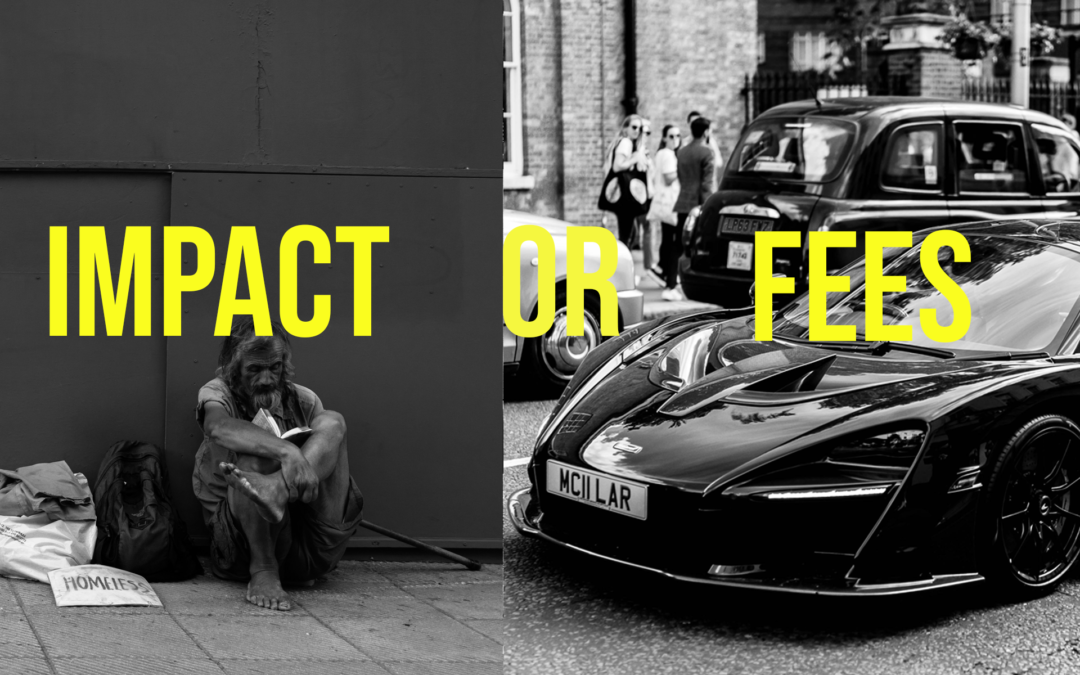What if instead of paying billions in fees that too rarely add value, investors only used passive listed equity funds, and the billions saved in fees were used for projects that have real impact on environment and society?
Let’s look into some numbers.
Value not added (on average) by the asset management industry
The latest April 2022 study by ESMA (European Securities and Markets Authority) on performance and costs of UCITS funds estimates average ongoing costs (essentially TER) of 1.4% for active equity funds and 0.8% for active bond funds (vs. ca 0.3% for passive/ETFs). The study estimates that active equity and bond UCITS represent ca. 70% respectively 80% of total AUM. It also estimates that on average active funds underperform by ca. 1% p.a. over a 10-year horizon net of costs. Because of the arithmetic law of active vs. passive management, a large active (and pseudo-active) investment management industry, even if highly qualified, does not improve its chances of outperforming. According to EFAMA, there are over 4’500 asset management companies in Europe. Assets under management are roughly 20 trillion if we include UCITS and AIF, ca. 2/3 in UCITS investing mostly in traditional asset classes and 1/3 in AIF – also partially investing in traditional asset classes.
Let’s make a very rough estimate here: if we take EUR 12tn of UCITS, consider that some 3/4 are active, and take an average TER of 1.1% between bonds and equities, we come to 100bn per year spent in (pointless, in aggregate) ongoing costs. We are talking tens of billions of EUR per year spent in costs that have been shown not to add value to investors, in aggregate. And if we take all investors in aggregate, we know overall costs paid for investing and trading cannot add value (arithmetic law elegantly explained by William Sharpe) vs. the market average.
The best use of capital and resources
Now, how about everyone moves to passive and all the money saved is invested in impact projects? Is the return for society higher when paying fees for investment services that on a net aggregate basis cannot add value, or use that money for impact projects, with a (real and honest) impact-investing approach? There are many asset managers and financial institutions that fund charitable activities and organisations. However, the numbers are negligible (despite the prominence sometimes in marketing materials) relative to the amount of industry fees. Fine, jobs are being created within the asset management industry, but is this the best way to use resources?
Do we want brains and energy channelled into a kind of asset management industry that actually does not and in practice cannot add value in aggregate net of (too high) costs? Are there bigger and more noble objectives that people could contributed to, while a few algorithms take care of the transactions required to run a couple of passive and super-low-cost funds?
Yes, but real impact
Of course, one also needs to be careful not to fall into the trap of greenwashing, impactwashing, etc. IMPACT investing does not mean investing in lightweight “sustainable” listed equity funds. It also does not mean investing in listed “impact” funds that probably should not even be allowed to call themselves “impact” – sometimes it really feels like an abuse of the word “impact” and its meaning in this context. Instead, when I say “impact”, I am thinking more of the PE and VC approach towards impact investing, provided it is done with a honest impact orientation, for example with proper theory-of-change type of thinking, effort and measurement (and not just the long impact reports with nice pictures). Some argue that creating jobs is already positive impact – the issue, however, has many nuances. A more detailed discussion of all this can be found in the Qortex module on sustainable and impact investing (link – half of the proceeds from subscriptions until the end of July will go to a Swiss charitable organisation supporting children education and coaching in developing countries, so it is not only useful for you, it also helps other people).
That said, impact investing management fees have to be commensurate and appropriate. Impact PE and VC involve a significant amount of work, but investors should not swallow excessive ongoing costs if these products do not add value, neither to investors, nor to society. That is why investors have to understand what real impact is, what greenwashing is, and so on. Ultimately, not only companies are responsible; consumers also have to consume in a responsible way – and savers making use of financial services and investment products, are indeed consumers with power and responsibility.
Conclusion
It is important for any saver and investor to understand all this, otherwise good intentions will be transformed into long reports full of nice pictures; positive impact will be nothing more than a label in a fund’s name.
At the same time, one should be aware of her or his goals: more investment returns? more impact? Of course the idea of impact investing is to combine impact with returns, but let’s be realistic – when investing, free lunches are very limited.
Photos from Unsplash – Jonathan Kho Ming Jun, Tom Grünbauer

